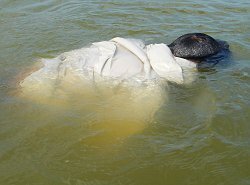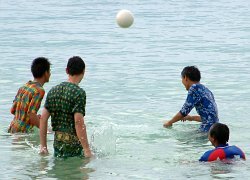Casualty Recognition
Casualty recognition is an important part of the initial situation assessment. Be clear of whom you're dealing with. It determines your course of action. Never put yourself in danger and add yourself to the casualty list.
Theory
Observation
Look at the pool or beach for 15 seconds.
Turn and describe what you saw.
Walk and Spot
Walk around the pool, spot a submerged object within 30 seconds.
This could be a rubber brick, an item of clothing, or a rescue training manikin.
Always remove any items from the pool when not in use to avoid false alarms.
Casualty Recognition
Before you start any rescue you want to know the status of any casualties you come across.
Discuss with your team the four most likely casualties,
conscious non swimmers,
conscious weak swimmers,
conscious injured swimmers, and
unconscious swimmers and their differences in treatment.
Consider hazards
Recognize and avoid danger.
Always minimise your involvement if possible.
Use rescue aids to avoid direct contact.
Non-swimmers can be very strong.
Be careful.
Contacting Emergency Services
Explain when to call an ambulance and how to do it.
If you're not sure how your local emergency services work, contact them on a non-emergency phone line and ask.
Mobilise the Mobile
The main priority of a rescue is to mobilise the mobile.
Ask everyone who can move to get out of the water.
This clears up the situation a bit prior to your rescue.
Practice Realistic Rescue Scenarios
Think of a variety of situations and what casualties would look like there. Keep it real. Don't dream up imaginary scenarios. The beach or pool is as you see it.
Consider that many casualties don't have the courtesy to change into swimwear before they get into trouble. Lifesavers too may not have the time to get changed either, unless you're Superman who always wears a Lycra swimsuit underneath his clothes.
Casualty Simulation and Recognition
Dress your class in different outfits to represent a variety of situations,
like boating gear, sportswear, or just casual clothes.
Rescuer wears red and yellow.
Split your class in pairs. One jumps in and simulates in random order a weak swimmer, non-swimmer, unconscious casualty, an injured casualty. The other guesses what casualty is simulated.
Then have the swimmers playing the casualties jump into the water and let your class guess what happened.
Finally get someone to rescue them accordingly.
Priorities in a Rescue: Mobilize the Mobile
Always minimise your involvement if possible. Consider hazards and casualties. Recognize and avoid danger. You don't want to add yourself to the casualty list.
Use a sequence of priorities to rescue multiple casualties. Get those at the top of the list first, because they require less of your time.
Conscious non swimmers
Conscious weak swimmers
Conscious injured swimmers
Unconscious swimmers
The reason for this is that an unconscious swimmer may have been in the water for some time already, and you may not be able to help them.
For water rescues the rule of thumb is to treat those making the least noise first, and the unconscious last.
Once you handle the unconscious casualty you won't have a chance to help the others.
Non Swimmers
 They are simply unable to swim and often positioned vertically in the water.
Some can be in a panic and thrash around.
They can be quite dangerous to the rescuer as they may grab hold of anyone who comes too close.
They are simply unable to swim and often positioned vertically in the water.
Some can be in a panic and thrash around.
They can be quite dangerous to the rescuer as they may grab hold of anyone who comes too close.
Weak Swimmers

They are either exhausted, unskilled, or unable to swim in clothes after falling in.
They are usually in a forward pointing position, like breast stroke, but at a steeper 45° angle. Often they are cooperative in a rescue.
Injured Swimmer
 They usually hold on to the injured body part.
They may be dazed or disoriented.
They usually hold on to the injured body part.
They may be dazed or disoriented.
Be careful when you pick them up so you don't injure them even further. Often they are cooperative in a rescue.
Unconscious Casualties
 They are floating motionless and face down in the water.
They need more care than others.
Hence you should get any other casualty out of the water first quickly.
Every minute counts.
They are floating motionless and face down in the water.
They need more care than others.
Hence you should get any other casualty out of the water first quickly.
Every minute counts.
Potential Casualties
 Snorkellers may get run over by boats
unless they wear bright clothing for better visibility.
They float motionless or move slowly, face down in the water.
Snorkellers may get run over by boats
unless they wear bright clothing for better visibility.
They float motionless or move slowly, face down in the water.
Potential Casualties
 Bathers who are distracted by games may not pay enough attention to what goes on around them.
They may step on something or bump into an obstacle.
Bathers who are distracted by games may not pay enough attention to what goes on around them.
They may step on something or bump into an obstacle.